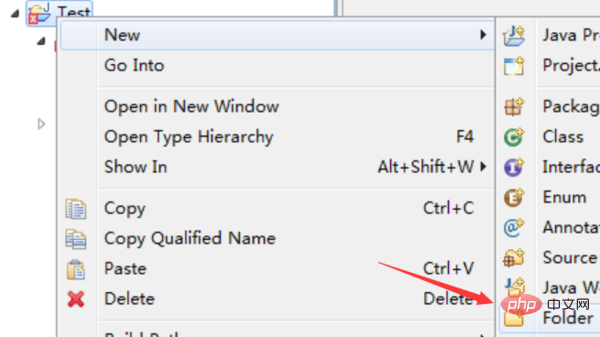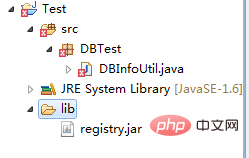How to import packages in java?
When you import certain packages into a java class (for example: import javax.servet.*), an error will be reported, indicating that this package does not exist. That's because the JRE System Library of the jdk we use does not contain servet_api.jar.

At this time we can download the required servlet-api.jar from the Internet or from the Tomcat lib subdirectory. So, how to import the corresponding jar package into the java project? Below we will explain the steps of
java import package
1. First, create a new folder under the project to save the jar package. Right-click on the project name, click [New] → [Floder] in sequence to open the window for creating a new folder

2. Enter the folder name [lib], Click [ok]. Jar packages imported from outside are usually stored in the lib folder

#3. Find the jar package to be imported, select the jar package you want to use with the mouse, and then hold down the left mouse button Without releasing the key, drag the jar package to the lib folder. Or copy the jar package first, then right-click on the lib folder and select copy. Open the selection box, select the default [copy files] in the pop-up selection box, and click [OK] to close. Then you can see the successfully copied jar package in the lib folder.


4. At this time, just copy the jar package to the project, but it cannot be used yet. You need to right-click on the project name and select
[Build Path]→[Configure Build Path...] in order.
5. In the opened window, select the [Libraries] page and click [add JARs...] from the button in the right column
6. In the opened window, expand the project and lib folder in order, then select the jar package just copied to the project, and click [OK] to close the window
7. In the [Libraries] page just opened, you can see the name of the jar package just introduced. Click [OK] to confirm.
8. At this time, in [Eclipse], you can find and start using this jar package.
The above is the detailed content of How to import packages in java?. For more information, please follow other related articles on the PHP Chinese website!

Hot AI Tools

Undresser.AI Undress
AI-powered app for creating realistic nude photos

AI Clothes Remover
Online AI tool for removing clothes from photos.

Undress AI Tool
Undress images for free

Clothoff.io
AI clothes remover

AI Hentai Generator
Generate AI Hentai for free.

Hot Article

Hot Tools

Notepad++7.3.1
Easy-to-use and free code editor

SublimeText3 Chinese version
Chinese version, very easy to use

Zend Studio 13.0.1
Powerful PHP integrated development environment

Dreamweaver CS6
Visual web development tools

SublimeText3 Mac version
God-level code editing software (SublimeText3)

Hot Topics
 Square Root in Java
Aug 30, 2024 pm 04:26 PM
Square Root in Java
Aug 30, 2024 pm 04:26 PM
Guide to Square Root in Java. Here we discuss how Square Root works in Java with example and its code implementation respectively.
 Perfect Number in Java
Aug 30, 2024 pm 04:28 PM
Perfect Number in Java
Aug 30, 2024 pm 04:28 PM
Guide to Perfect Number in Java. Here we discuss the Definition, How to check Perfect number in Java?, examples with code implementation.
 Random Number Generator in Java
Aug 30, 2024 pm 04:27 PM
Random Number Generator in Java
Aug 30, 2024 pm 04:27 PM
Guide to Random Number Generator in Java. Here we discuss Functions in Java with examples and two different Generators with ther examples.
 Armstrong Number in Java
Aug 30, 2024 pm 04:26 PM
Armstrong Number in Java
Aug 30, 2024 pm 04:26 PM
Guide to the Armstrong Number in Java. Here we discuss an introduction to Armstrong's number in java along with some of the code.
 Weka in Java
Aug 30, 2024 pm 04:28 PM
Weka in Java
Aug 30, 2024 pm 04:28 PM
Guide to Weka in Java. Here we discuss the Introduction, how to use weka java, the type of platform, and advantages with examples.
 Smith Number in Java
Aug 30, 2024 pm 04:28 PM
Smith Number in Java
Aug 30, 2024 pm 04:28 PM
Guide to Smith Number in Java. Here we discuss the Definition, How to check smith number in Java? example with code implementation.
 Java Spring Interview Questions
Aug 30, 2024 pm 04:29 PM
Java Spring Interview Questions
Aug 30, 2024 pm 04:29 PM
In this article, we have kept the most asked Java Spring Interview Questions with their detailed answers. So that you can crack the interview.
 Break or return from Java 8 stream forEach?
Feb 07, 2025 pm 12:09 PM
Break or return from Java 8 stream forEach?
Feb 07, 2025 pm 12:09 PM
Java 8 introduces the Stream API, providing a powerful and expressive way to process data collections. However, a common question when using Stream is: How to break or return from a forEach operation? Traditional loops allow for early interruption or return, but Stream's forEach method does not directly support this method. This article will explain the reasons and explore alternative methods for implementing premature termination in Stream processing systems. Further reading: Java Stream API improvements Understand Stream forEach The forEach method is a terminal operation that performs one operation on each element in the Stream. Its design intention is











